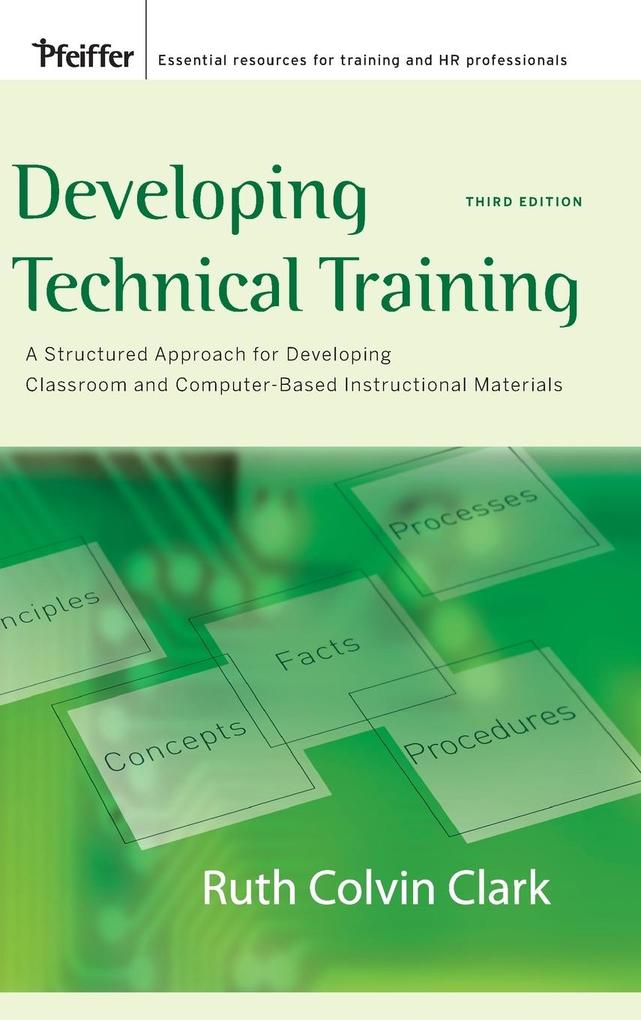
Zustellung: Mi, 25.06. - Mo, 30.06.
Versand in 2 Wochen
VersandkostenfreiBestellen & in Filiale abholen:
Developing Technical Training THIRD EDITION SINCE IT WAS first published almost twenty years ago, Developing Technical Training has been a reliable resource for both new and seasoned training specialists. The third edition of this classic book outlines a systematic approach called the Instructional Systems Design (ISD) process that shows how to teach technical content defined as facts, concepts, processes, procedures, and principles. Whether you teach "hard" or "soft" skills, or design lessons for workbooks or computers, you will find the best training methods in this book. Using these techniques, you can create learning environments that will lead to the most efficient and effective acquisition of new knowledge and skills. Throughout the book, Ruth Colvin Clark defines each content type and illustrates how to implement the best instructional methods for delivery in either print or e-learning media. This new edition includes all new guidelines and examples illustrating how to adapt training methods for new digital learning environments including synchronous, asynchronous, and mobile technologies. Developing Technical Training is written for new training specialists or subject-matter experts to help them:
- Follow a systematic process to define training content and develop training materials
- Identify the key instructional methods including practice exercises needed to teach facts, concepts, processes, procedures, and principles
- Design powerful practice exercises that will lead to learning
- Construct test questions to match learning objectives and type of content
- Provides a framework for assessment and principles of first line treatment
Inhaltsverzeichnis
Acknowledgments xi
Introduction 1
Section One: An Introduction to the Technology of Training 3
1. The Technology of Training 5
2. An Introduction to Structured Lesson Design 33
Section Two: How to Teach Facts, Concepts, Processes, Procedures, and Principles 55
3. How to Teach Procedures 59
4. How to Teach Concepts 81
5. How to Teach Facts 105
6. How to Teach Processes 125
7. How to Teach Principles 145
Section Three: How to Organize Your Lessons and Exploit e-Learning Features 181
8. Organizing Your Training Content 183
9. e-Learning Design 211
Appendix: Exercises 229
Glossary 239
References 259
Index 263
About the Author 269
Pfeiffer Publication Guide 271
Introduction 1
Section One: An Introduction to the Technology of Training 3
1. The Technology of Training 5
2. An Introduction to Structured Lesson Design 33
Section Two: How to Teach Facts, Concepts, Processes, Procedures, and Principles 55
3. How to Teach Procedures 59
4. How to Teach Concepts 81
5. How to Teach Facts 105
6. How to Teach Processes 125
7. How to Teach Principles 145
Section Three: How to Organize Your Lessons and Exploit e-Learning Features 181
8. Organizing Your Training Content 183
9. e-Learning Design 211
Appendix: Exercises 229
Glossary 239
References 259
Index 263
About the Author 269
Pfeiffer Publication Guide 271
Produktdetails
Erscheinungsdatum
01. Dezember 2007
Sprache
englisch
Auflage
3rd edition
Seitenanzahl
288
Autor/Autorin
Ruth C Clark
Verlag/Hersteller
Produktart
gebunden
Gewicht
576 g
Größe (L/B/H)
235/157/20 mm
ISBN
9780787988463
Entdecken Sie mehr
Bewertungen
0 Bewertungen
Es wurden noch keine Bewertungen abgegeben. Schreiben Sie die erste Bewertung zu "Developing Technical Training" und helfen Sie damit anderen bei der Kaufentscheidung.










